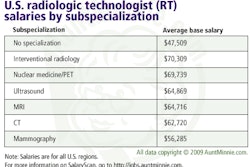Many radiology residents may not fully understand the opportunities available in pediatric imaging -- perhaps accounting for the discipline's current shortage of radiologists, according to a new survey conducted by the Society for Pediatric Radiology (SPR) of Reston, VA.
The SPR conducted a survey of 1,000 radiology residents, with the goal of identifying how to attract residents to specialize in pediatric radiology. They received completed responses from 332 residents, and results will be published in the September issue of the Journal of the American College of Radiology.
The questionnaire consisted of five sections focusing on fellowship and career plans, 20 factors that might affect choices of fellowship, trainees' personal perceptions, and nonidentifiable personal information including demographics.
The respondents were predominantly male (66%) and in their third or fourth year of residency (70%) in an academic or university hospital (75%). They were an average age of 31 years, and one-third had children. Eighty-one percent were planning to pursue radiology fellowships after residency and 12% thought that they might do so.
The top five preferred subspecialties that the residents were considering were body imaging (15.7%), neuroradiology (15.1%), interventional radiology (14.2%), musculoskeletal imaging (13.4%), and women's imaging (9.8%). Some 7% of the respondents indicated a primary interest in pediatric radiology.
Factors that ranked significantly higher for residents considering a pediatric radiology specialty included the ability to have more patient contact, being part of a multidisciplinary clinical team, the health of the patient, and altruism. By comparison, residents considering women's imaging ranked favorable work hours and little or no call responsibilities high on their lists.
All participants believed that salaries in nonpediatric specialties were at least $60,000 higher, on average, five years after completing a fellowship than salaries in pediatric radiology. Although financial compensation was in the bottom half of decision-making factors, 27% of the respondents indicated that they would require better compensation before considering a career in pediatric radiology. They estimated the salary of pediatric radiologists to be $290,000 per year, compared to $401,000 in other subspecialties.
Based on the survey results, the SPR recommends that residents gain firsthand experiences early in their residencies with specialties that have shortages. The organization suggests that the pediatric rotation be scheduled for the resident's second year, rather than late in the third year as it currently exists.
Related Reading
Multiple industry trends increase demand for subspecialty radiology, October 5, 2006
New efforts urged to 'save' pediatric radiology, June 14, 2005
Copyright © 2009 AuntMinnie.com



















